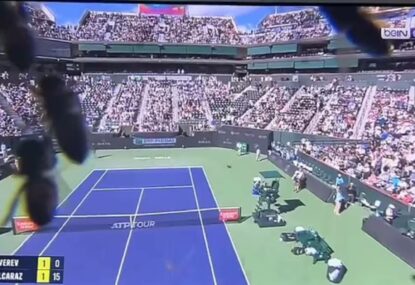This is the rarely told story of a famous unknown.
Roland Garros, a name synonymous with tennis the world over, and after whom the famous stadium that hosts the French Open is named, was not a champion tennis player, or even a tennis official.
For the people of France, he was much more than just a sporting hero, yet almost nobody outside of France knows who he was.
Eugene Adrien Roland Georges Garros was a pioneering aviator, innovative engineer, concert pianist, legion of honour recipient and a World War 1 fighter pilot. Very popular with the fairer sex, Garros enjoyed celebrity in pre-war France as a James Bond like figure.
Stade Roland Garros was constructed in 1928. The previous year the French tennis team had upset the might of the USA in Philadelphia to win what is now known as the Davis Cup.
The team, known as ‘les Mousquetaires’ or the ‘Four Musketeers’ included a young star – a 23-year-old by the name of Rene Lacoste. Nicknamed ‘The Crocodile’ by fans for his fighting qualities on the court, Lacoste won both his singles matches in an inspired 3-2 French victory. A few years later he would found a company producing tennis shirts with a crocodile/ alligator as the logo – a company now valued at €1.25 billion.
In those days the tournament format meant the current holders had the right to defend their title at home the following year against the best challenger, essentially gaining a free pass to the final. The win of the ‘Four Musketeers’ meant that France would now defend the title for the first time ever on home soil in 1928. It was decided that for an event of this stature, a new stadium must be built.
At that time the French Championships (now the French Open) had been leading a nomadic life, having been staged at a number of venues in the early part of the century, most recently at the very select Stade Francais Sports Club. Stade Francais generously donated three hectares of land at a new site on the outskirts of Paris for the new purpose built tennis stadium – on one condition – it would be named after one of its former members, a close friend of the current president. A man who had little to do with tennis at all – Roland Garros.
The man
Garros was in fact a daring airman who won fame before the war competing successfully in prestigious air races of the time such as Paris-Madrid, the Circuit of Europe, and winning the Circuit de Anjou race in 1912. He established a new altitude world record of 5610m in 1912, and in 1913 became the first man to fly non-stop across the Mediterranean from France to Africa.
Garros happened to be in Berlin when WWI was declared, and under house arrest and facing likely internment, climbed out the bathroom window during the night, scurrying to his waiting nearby aircraft. After stowing a couple of gasoline cans on board, he flew away under the cover of darkness (almost unheard of at the time), back home to France.
Exempt from the draft, Garros decided to join the war effort anyway in 1914. Garros the inventor gained notoriety for pioneering the first forward facing machine gun that could be fired through a propeller arc without destroying it. The technology saw his aircraft the most lethal in the air, and Garros became the first fighter pilot in history.
Despite being so short sighted he wore glasses underneath his goggles, he created terror among German pilots in early April 1915, shooting down three German aircraft, and gaining a commendation for bravery.
But disaster struck on 18 April 1915 – Garros’ plane was grounded in enemy territory and he became a POW.
A POW for almost three years, in April 1918 after several unsuccessful escape attempts, Garros broke out his POW camp disguised as a German officer using uniforms he had made in secret. In what resembled a plot of Hollywood film, he slept in a cemetery and hid out in a cinema, before making his way back through the Netherlands and London and rejoining the French Army.
Garros was greeted in person by the French leader Georges Clemenceau and was offered a non combat role as an advisor, but was desperate to get back into the air. Returning as a fighter pilot he claimed two further victories on 2 October 1918, only one of which was confirmed.
On 5 October, just three days later, tragedy struck as he took part in one last fateful mission. It was reported he was shot down by a German Fokker aircraft and killed, just five weeks before Armistice Day, and one day shy of his 30th birthday.
The myth
Garros was an accomplished athlete but was not a tennis player. He was a champion cyclist at school and also played rugby and football.
Garros is erroneously called the world’s first fighter ace. The definition of a fighter ace is five victories, but only four of Garros’ victories were confirmed. The honour of first fighter ace actually went to another Frenchman – Adolphe Pegoud.
The nature of Garros solitary victories captured the public imagination and led to hysteria in the press. On 3 August 1914 it was reported in London that Garros had heroically rammed a military Zeppelin, destroying the airship and losing his life in the process!
Reports differ on the cause of Garros’ first crash landing over enemy lines in 1915. Varying reports describe the cause as a clogged fuel line, engine failure, or that he was hit by enemy ground fire.
It is widely reported that Garros tried to set fire to his plane in an attempt to hide the secrets of his forward facing machine gun. He was captured before he could complete the task however, and the aircraft fell in to enemy hands – his failure credited by many as kick-starting Germany’s superiority in the skies.
Although his aircraft was investigated by the Germans in particular by the famous aviation mechanic Anthony Fokker, the system later developed by Fokker was in fact a completely different system, and far more effective than Garros’ initial design.
Legend has it that while in the POW camp, Garros sent coded messages back to France to arrange delivery of two tennis racquets with hollow handles containing a map of Germany and a felt hat which he used as part of his escape disguise.
The final demise of Roland Garros also remains a mystery. No German fighter pilot ever claimed victory against Garros that day in October 1918. One theory is that it could have been another mechanical problem; perhaps even with Garros’ own firing system which caused him to shoot off his own propeller.
The Legend
The President of the prestigious Stade Francais Athletic association at the time the new stadium was commissioned was Emile Lesieur – a French international rugby player, as well as a friend, classmate and comrade of Garros during the war. In fact it was Lesieur who had sponsored Garros’ entry to the extremely exclusive club. He insisted “I won’t spend a penny if we don’t give the name of my friend Garros to this new stadium.”
Ten years after he was killed during the war, Roland Garros, who actually far preferred the game of rugby, became the new emblem of French tennis.
His name lives on as the home of the French Open, a tournament with a worldwide TV audience of three billion people in over 200 countries. Garros fighting spirit now lives on in these more frivolous forms of battle.
The airport on the Indian Ocean island of Reunion where Garros was born is also named in his honour. The street in Reunion where he grew up has also been renamed Roland Garros Street.
The Four Musketeers would go on to win six consecutive Davis Cup titles at the newly built Roland Garros Stadium, forever cementing the name Roland Garros in the hearts of French sports fans. The feat has never been matched.




































































































